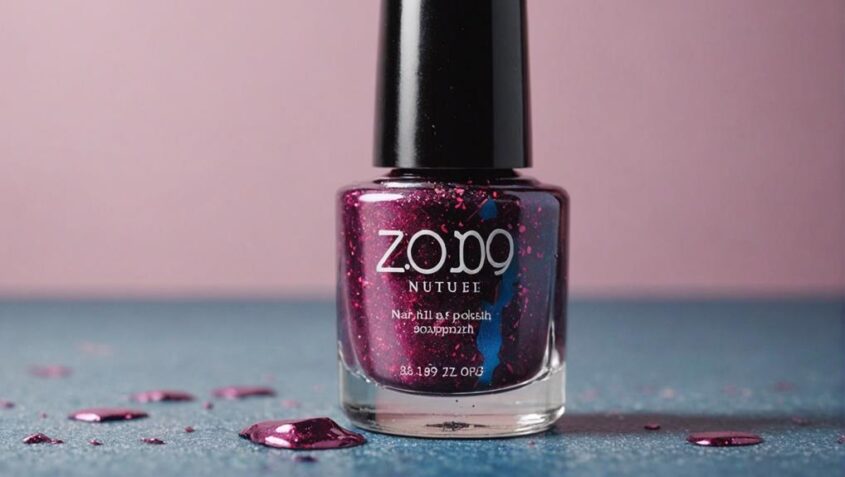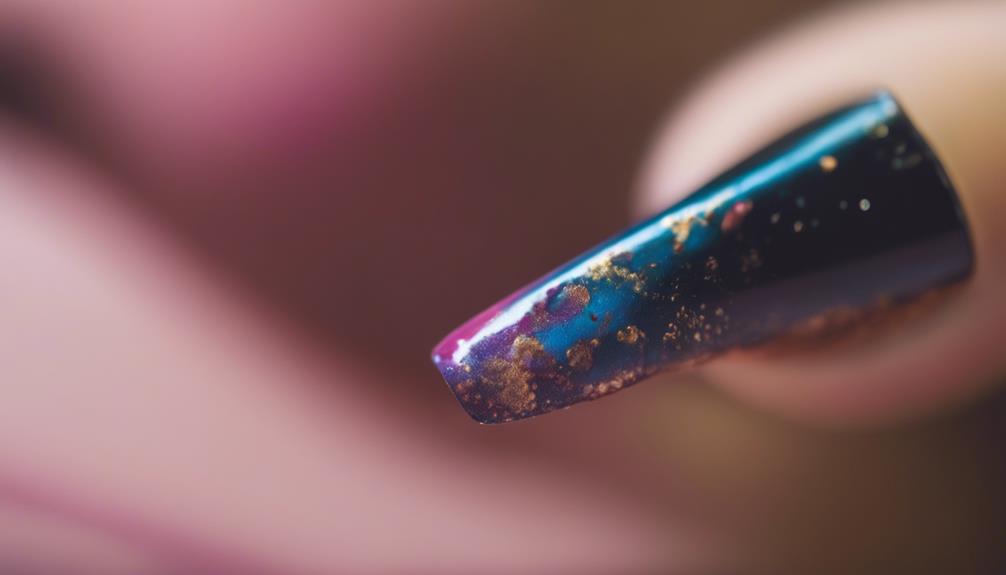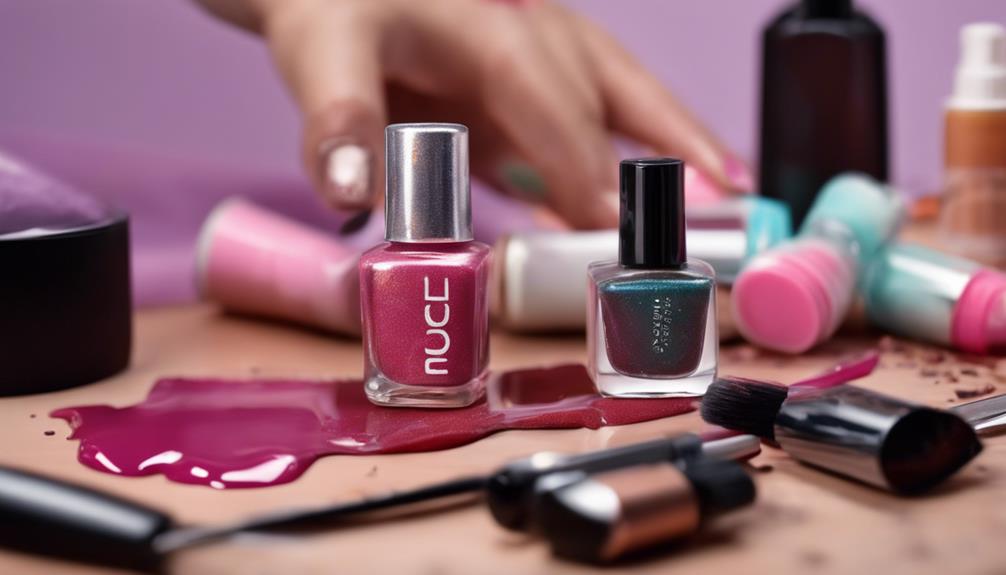Can You Use 20 Year Old Nail Polish?

Using 20-year-old nail polish may lead to clumping, streaky application, and potential bacterial contamination. Changes in composition over time can affect the finish and quality of your manicure. Chemical degradation can pose risks to both your nails and health. Signs of spoilage like texture changes, color separation, and odd odors indicate the polish is past its prime. Before use, inspect, shake gently, and test a small area for reactions. Secure storage per expert recommendations can help maintain polish integrity. Learn more about the risks and guidelines in handling vintage nail polish for a safer application.
Key Takeaways
- Check for changes in texture, color, and odor before using.
- Test on a small area for adverse reactions.
- Consider using a nail polish thinner if needed.
- Wear gloves for protection from harmful ingredients.
- Ensure proper ventilation when using old nail polish.
Potential Risks of Using Old Nail Polish

Using old nail polish may pose potential risks to both the appearance of your nails and your overall nail health. As nail polish ages, its composition can change, leading to issues such as clumping, separation, and a streaky application. These changes can result in an uneven and unattractive finish on your nails, compromising the aesthetic appeal you desire. Beyond the cosmetic concerns, expired nail polish can also harbor bacteria, which may increase the risk of nail infections and other adverse reactions.
Furthermore, the ingredients in old nail polish may degrade over time, making them less effective and potentially harmful to your nails. For example, chemicals like formaldehyde and toluene can become more concentrated as the polish ages, increasing the likelihood of causing dryness, brittleness, and discoloration in your nails. To maintain both the beauty and health of your nails, it is advisable to regularly inspect your nail polish collection for signs of spoilage and replace any products that have surpassed their recommended shelf life.
Signs of Spoilage in Nail Polish
Visible signs of spoilage in nail polish can include changes in texture, color, and odor. When nail polish starts to spoil, the texture may become clumpy or stringy, making it difficult to apply smoothly on nails. Additionally, the color of the polish may darken or separate, indicating that the formula is breaking down. Unpleasant odors, such as a strong chemical smell or a rancid odor, are also common signs of spoilage in nail polish. These changes suggest that the ingredients in the polish have deteriorated over time, affecting the overall quality and performance of the product.
It is essential to pay attention to these visible signs of spoilage to determine if a nail polish is still safe and effective to use. Using spoiled nail polish can result in streaky and uneven application, leading to unsatisfactory nail finishes. To avoid these issues, it is recommended to regularly inspect your nail polish collection for any signs of spoilage and replace old or expired products promptly.
How to Extend the Lifespan of Nail Polish

To prolong the longevity of your nail polish collection, implementing proper storage techniques is crucial. Storing your nail polish correctly can help maintain its quality and prevent premature spoilage. Here are some innovative tips to extend the lifespan of your nail polish:
- Store in a cool, dark place: Exposure to light and heat can cause the nail polish to deteriorate faster. Keeping your nail polish in a cool, dark location can help preserve its color and consistency.
- Tighten caps securely: Make sure to tighten the caps of your nail polish bottles securely after each use. This prevents air from entering the bottle and drying out the polish.
- Avoid shaking: Instead of shaking the nail polish bottle to mix the formula, roll it between your palms. Shaking can introduce air bubbles, leading to a clumpy application.
- Clean the bottle neck: Wipe the neck of the nail polish bottle with a clean cloth or acetone to prevent the cap from sticking due to dried polish.
- Use a nail polish thinner: If your nail polish starts to thicken over time, adding a few drops of nail polish thinner can help restore its original consistency.
Safe Practices for Using Vintage Nail Polish
When handling vintage nail polish, it is essential to prioritize safety by following specific guidelines to ensure proper application and prevent any potential risks. Before using vintage nail polish, inspect the bottle for any signs of separation, unusual odors, or changes in color. Shake the bottle gently to mix the formula, but avoid vigorous shaking to prevent air bubbles that may affect the application. Test the polish on a small area of the nail to check for any adverse reactions or changes in texture. It is advisable to wear gloves to protect your skin from potentially harmful ingredients that may have degraded over time. Additionally, ensure proper ventilation in the room to minimize inhalation of fumes. Store vintage nail polish away from direct sunlight and extreme temperatures to maintain its quality. By following these safe practices, you can enjoy using your vintage nail polish collection while prioritizing your well-being.
Expert Recommendations for Nail Polish Storage

Proper storage of nail polish is crucial to maintaining its quality and longevity, according to experts in the beauty industry. To ensure your nail polishes remain in top condition and ready for use, consider the following expert recommendations:
- Store Away from Light: Exposure to light can cause nail polish to change color and become thick. Keep your nail polishes in a dark place to maintain their original hue.
- Maintain Cool Temperatures: Extreme heat can alter the consistency of nail polish. Store your collection in a cool area to prevent separation or clumping.
- Avoid Humidity: Humidity can lead to the evaporation of solvents in nail polish, making it gloopy. Store your nail polishes in a dry environment to maintain their smooth application.
- Secure Lids Tightly: Properly sealing nail polish bottles prevents air from entering and drying out the formula. Ensure all lids are securely closed after each use.
- Store Upright: Storing nail polish bottles upright helps prevent leaks and maintains the integrity of the formula. Keep them standing to avoid spills and maintain the polish's quality.
Frequently Asked Questions
Can Old Nail Polish Be Harmful to Your Nails?
Old nail polish can be harmful to nails due to potential chemical changes over time, leading to uneven application and adverse reactions. It's advisable to regularly check polish expiration dates, prioritize quality brands, and maintain proper storage conditions.
Will Expired Nail Polish Damage My Nails?
Expired nail polish can potentially damage nails due to changes in formula leading to uneven application, chipping, or discoloration. To maintain nail health, it's advisable to discard old polish and use fresh products for optimal results.
Can Using Old Nail Polish Cause Allergic Reactions?
Using old nail polish can potentially cause allergic reactions due to its chemical composition breaking down over time. Always check for changes in color, consistency, or odor before using. Consult a dermatologist if any reactions occur.
Is It Safe to Use Vintage Nail Polish on Children?
When considering the safety of using vintage nail polish on children, it's essential to prioritize their well-being. Due to the potential risks of old cosmetics, it's advisable to opt for newer, tested products to prevent any adverse reactions.
Can Old Nail Polish Change Its Color or Consistency?
Old nail polish may undergo color and consistency changes due to evaporation of solvents or exposure to air. These alterations can render the product less effective or aesthetically pleasing. It's recommended to discard aged nail polish for optimal performance.




